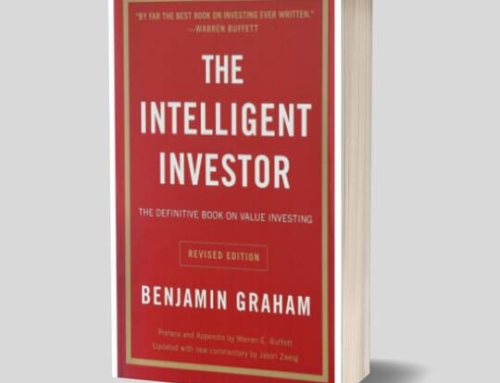The Little Book of Valuation
How do you know how much a share in Reliance is worth? For that matter, how about Vodafone Idea or even Maruti Udyog Limited? Unlike a painting or a sculpture, the value of a company’s stock is not in the eyes of the beholder. So if you’re one of those people who have always thought that the price of a stock doesn’t matter, as long as someone else is willing to pay more for it, think again.
This greater fool theory, as it is referred to, can be an expensive game to play as the investing community collectively proved it during the dot-com bubble. Why? That’s because at its core, valuing a company is simple and in this video, we’ll show you how? This is a Top 5 takeaway summary of “The Little Book of Valuation ” written by Aswath Damodaran.
Takeaway No 1.
Two valuation approaches, Relative and Intrinsic value
Valuing a stock market company can be done using two major approaches, the relative and the intrinsic value approach. The relative value approach is based on a single premise, which is that everyone prefers to pay as little as possible for identical assets. The intrinsic approach is based on two major premises. Everyone prefers money today over money tomorrow, and everyone prefers a sure bet over a risky one. Some people may favor one method over the other one, but I think that both are useful. Our investing strategy consists of first using our relative approach to screen for companies and later usage of an intrinsic approach to decide if the individual company is worth our money. With that said, let’s dive deeper into both of these.
Takeaway No 2.
A quick guide to relative valuation
What would you prefer? Buying a house for $200,000 or buying the neighboring house for $300,000. Sounds like a silly question, but this is the basis for relative valuation. You compare an asset with another one that is as similar as possible and simply pick the cheaper alternative. In the stock market, it is never as clear-cut as mentioned in this example, but the premise is still the same. The 3 essential steps for relative valuation are mentioned below.
- Find comparable assets: We must compare apples to apples and oranges to oranges. If we take the companies that we talked about at the beginning of this video, it’s easier to find comparisons for Vodafone Idea and Maruti Udyog Limited while it’s more difficult for Reliance Industries.
- Use a standardized variable: To be able to compare these companies with each other, we cannot just look at the prices of the businesses and pick the cheapest ones. We must scale the price to another variable. Scaling price to earnings by using the so-called price to earnings or PE multiple is a good place to start.
- Adjust for differences: We’re not quite there yet to pick Walmart over Amazon, just because its PE is lower. It doesn’t make much sense. Usually, a company trades at a lower multiple than another because its earnings growth is expected to be lower in the future. While historical earnings growth isn’t in any way a guarantee for future growth, it can be used for reference and to find interesting prospects. Verizon and Royal Dutch Shell are both cheaper and have experienced a stronger growth in earnings than their peers, which makes them an interesting case for further analysis. In relative valuation, we assume that the market is correct on average, but wrong on an individual company level. However, it didn’t make much sense to pick one of the dot-com companies in 1999 at a PE of 100, just because it seemed cheap relative to its competitors that had a PE of 200 and therefore this assumption may be flawed. Hence, relative valuations, in our opinion, should always be accompanied by intrinsic ones.
Takeaway No 3.
A quick guide to intrinsic evaluation
What would you prefer? Rs.10,000 today or One Lakh rupees per year for the next 10 years. So then, we have established our first principle. Everyone prefers money today over tomorrow. There are plenty of reasons for this, but two of the more important ones are Instant Gratification and Inflation.
Now think about this one. What would you prefer? I’ll give you a thousand rupees or you’ll have to flip a coin. Heads, You get Rs.2000 and Tails, you get nothing at all. Excellent. Then we have established our second principle too. Everyone prefers a sure bet over a risky one.
Combining these 2 premises helps us in understanding the most important variable in an intrinsic valuation, often referred to as a Discounted Cash Flow analysis. This is the so-called Discount Rate. The discount rate determines how much less a future income is worth to you and hence the rates should be higher.
If you use a 15% discount rate, you essentially say that Rs.1000/- the next year is worth only Rs.870 /- today. Rs.1000/- in 3 years is worth only Rs.658/- and in 10 years it will be worth only Rs.247/-. The discount rate could also be viewed as how much yearly return that you demand for that asset.
Now, how do we apply this in the stock market? Well, first and foremost, we must remember what a share in a company is? A share in a company is a claim against a certain portion of the future earnings of the same company.
For instance, if you hold one share in Reliance, you are entitled to 1 out of 500 crores of the future earnings of Reliance. To get a little bit technical we are not interested in net income, but rather something like Warren Buffett’s owner’s earnings. If we could say with certainty what the owner’s earnings would be from this day to infinity and use our previously determined discount rate to translate the earnings into today’s value. We could say what the equity in a company is truly worth. If we divide that with the number of shares outstanding, we could say what a single share is worth. If the price of the share is lower than the value that we came up with, we would buy the stock and vice versa.
Calculating anything from now to infinity sounds like a daunting task. So we usually estimate the owner’s earnings for the first 10 years or so, and then calculate something called a Going Concern Value. The owner’s earnings for the first 10 years plus the going concern value determines the total value of the company. Remember that you are not looking for a stock that you estimate is worth something like 10% more than the price you want. Use the discount rate that you require for your investments, say 15%, and then make sure that your intrinsic value calculation is at least something like 40% on the value. As you can see calculating the intrinsic value of overstock is simple, but not easy.
Estimating 10 years of the owner’s earnings involves a lot of assumptions. For instance, how fast will the revenue be able to grow during these years? How high can the company maintain its profit margins and how much capital expenses will be required to support this? Your results from this valuation technique will be no better than those underlying assumptions. Therefore, in takeaway number five, I will give you some guidelines for three common situations.
Takeaway No 4.
The truth about Valuations
Even a common notion of relative and intrinsic valuation comes with its flaws. By being aware of these flaws, you can improve your odds of picking the right stocks. All valuations are biased. Why did you ask if you made a 20% revenue growth per year for the next 10 years for Reliance and not 10%?
Choices like these will have major impacts on the valuations that you make. You also want to be sure that you are as rational as possible in your assumptions. Maybe you like the personality of Mr Ambani, maybe you already own stocks in the company, or maybe a friend of yours is on the Board of Reliance Industries. Be aware of this and question your assumptions one more time. If you know that you’re at risk, most valuations are wrong. Unfortunately, this shouldn’t stop you because relative and intrinsic valuations are the two best tools that we have and all investors are facing the same uncertainty.
Further, it sometimes doesn’t matter if your valuation is off by saying 30% because the stock is so clearly undervalued. Less is sometimes more. Take the estimation of future revenue growth as an example.
There are so many variables that could go into this, but you have to be careful not to include too many of them in your analysis. Focus on just a few of the most important ones, perhaps competition, quality of management, and the potential size of the market, and leave the other ones out. Including too many variables will often cause you to miss the forest for the trees.
Takeaway No 5.
Context matters
Growth, Decline, and Cyclicals.
Depending on what type of company that you are dealing with, you will have to adjust your relative and intrinsic analysis.
For example, valuing Reliance as a growth company, Vodafone Idea as a company in decline, and Maruti Udyog Limited as a highly cyclical commodity company will present different difficulties. In the case of Reliance, the growth company, how scalable the revenue growth is, will it be of major importance as suggested before it starts evaluating competition, quality of management, and the size of the overall market?
Future profit margins are another concern and they typically will increase as the company matures. Having margins scale up from the current level to that of an industry average over time is probably a good idea. Don’t wait too long before putting the company into stable growth used for the going concern value. A strong growth company will not be able to grow as it did previously. Its size in itself will be its Achilles’ heel. Companies like HUL and Colgate-Palmolive are prime examples.
You don’t want the company to throw good money after bad as Warren buffet says, should you find yourself in a chronically leaking boat. Time and Energy spent in changing vessels is likely to be more productive than spent in plugging the leak. An interesting property of companies in decline is that the risk for bankruptcy increases a lot. We must take this into account during valuation. Determine a value for the company if it survives together with the value of the company if it defaults and attaches probabilities to both of these outcomes.
If the company defaults, it probably has a lot of assets that can be sold off the balance sheet, and therefore it becomes much more important for the valuation of a company in decline than for instance, the growing company.
IN the case of cyclical companies like Maruti Udyog Limited, results vary a lot over a normal business cycle. One of the most interesting properties that they have is that they often seem the most undervalued at the top of the market cycle or the top of commodity prices and the most overvalued at the bottom. In reality, the opposite is true. For these companies, it becomes important to normalize earnings, to be able to make fat comparisons and intrinsic valuations.
For a commodity company, you can use the average price of the commodity of the past 10 years, for instance, to see how it impacts revenues and net earnings. For an industrial company, you can use the average profit models over a whole business cycle.
So, that’s about it and we have thus ended the review of this wonderful book written by Aswath Damodaran.
NOTE: This article is inspired by the Swedish Investor’s interpretation of the book. We thank him for all the awesome work he has done.
Howdy!
If you’re here for the first time, let’s get introduced.
VRD Nation is India’s premier stock market training institute and we (Team VRD Nation) are passionate about teaching each and every aspect of investing and trading.
If you’re here for the first time, don’t forget to check out “Free Training” section where we have tons of free videos and articles to kick start your stock market journey.
Also, we got two awesome YouTube channels where you can continue the learning process.
Must-Read Articles
The Little Book of Valuation
How do you know how much a share in Reliance is worth? For that matter, how about Vodafone Idea or even Maruti Udyog Limited? Unlike a painting or a sculpture, the value of a company’s stock is not in the eyes of the beholder. So if you’re one of those people who have always thought that the price of a stock doesn’t matter, as long as someone else is willing to pay more for it, think again.
This greater fool theory, as it is referred to, can be an expensive game to play as the investing community collectively proved it during the dot-com bubble. Why? That’s because at its core, valuing a company is simple and in this video, we’ll show you how? This is a Top 5 takeaway summary of “The Little Book of Valuation ” written by Aswath Damodaran.
Takeaway No 1.
Two valuation approaches, Relative and Intrinsic value
Valuing a stock market company can be done using two major approaches, the relative and the intrinsic value approach. The relative value approach is based on a single premise, which is that everyone prefers to pay as little as possible for identical assets. The intrinsic approach is based on two major premises. Everyone prefers money today over money tomorrow, and everyone prefers a sure bet over a risky one. Some people may favor one method over the other one, but I think that both are useful. Our investing strategy consists of first using our relative approach to screen for companies and later usage of an intrinsic approach to decide if the individual company is worth our money. With that said, let’s dive deeper into both of these.
Takeaway No 2.
A quick guide to relative valuation
What would you prefer? Buying a house for $200,000 or buying the neighboring house for $300,000. Sounds like a silly question, but this is the basis for relative valuation. You compare an asset with another one that is as similar as possible and simply pick the cheaper alternative. In the stock market, it is never as clear-cut as mentioned in this example, but the premise is still the same. The 3 essential steps for relative valuation are mentioned below.
- Find comparable assets: We must compare apples to apples and oranges to oranges. If we take the companies that we talked about at the beginning of this video, it’s easier to find comparisons for Vodafone Idea and Maruti Udyog Limited while it’s more difficult for Reliance Industries.
- Use a standardized variable: To be able to compare these companies with each other, we cannot just look at the prices of the businesses and pick the cheapest ones. We must scale the price to another variable. Scaling price to earnings by using the so-called price to earnings or PE multiple is a good place to start.
- Adjust for differences: We’re not quite there yet to pick Walmart over Amazon, just because its PE is lower. It doesn’t make much sense. Usually, a company trades at a lower multiple than another because its earnings growth is expected to be lower in the future. While historical earnings growth isn’t in any way a guarantee for future growth, it can be used for reference and to find interesting prospects. Verizon and Royal Dutch Shell are both cheaper and have experienced a stronger growth in earnings than their peers, which makes them an interesting case for further analysis. In relative valuation, we assume that the market is correct on average, but wrong on an individual company level. However, it didn’t make much sense to pick one of the dot-com companies in 1999 at a PE of 100, just because it seemed cheap relative to its competitors that had a PE of 200 and therefore this assumption may be flawed. Hence, relative valuations, in our opinion, should always be accompanied by intrinsic ones.
Takeaway No 3.
A quick guide to intrinsic evaluation
What would you prefer? Rs.10,000 today or One Lakh rupees per year for the next 10 years. So then, we have established our first principle. Everyone prefers money today over tomorrow. There are plenty of reasons for this, but two of the more important ones are Instant Gratification and Inflation.
Now think about this one. What would you prefer? I’ll give you a thousand rupees or you’ll have to flip a coin. Heads, You get Rs.2000 and Tails, you get nothing at all. Excellent. Then we have established our second principle too. Everyone prefers a sure bet over a risky one.
Combining these 2 premises helps us in understanding the most important variable in an intrinsic valuation, often referred to as a Discounted Cash Flow analysis. This is the so-called Discount Rate. The discount rate determines how much less a future income is worth to you and hence the rates should be higher.
If you use a 15% discount rate, you essentially say that Rs.1000/- the next year is worth only Rs.870 /- today. Rs.1000/- in 3 years is worth only Rs.658/- and in 10 years it will be worth only Rs.247/-. The discount rate could also be viewed as how much yearly return that you demand for that asset.
Now, how do we apply this in the stock market? Well, first and foremost, we must remember what a share in a company is? A share in a company is a claim against a certain portion of the future earnings of the same company.
For instance, if you hold one share in Reliance, you are entitled to 1 out of 500 crores of the future earnings of Reliance. To get a little bit technical we are not interested in net income, but rather something like Warren Buffett’s owner’s earnings. If we could say with certainty what the owner’s earnings would be from this day to infinity and use our previously determined discount rate to translate the earnings into today’s value. We could say what the equity in a company is truly worth. If we divide that with the number of shares outstanding, we could say what a single share is worth. If the price of the share is lower than the value that we came up with, we would buy the stock and vice versa.
Calculating anything from now to infinity sounds like a daunting task. So we usually estimate the owner’s earnings for the first 10 years or so, and then calculate something called a Going Concern Value. The owner’s earnings for the first 10 years plus the going concern value determines the total value of the company. Remember that you are not looking for a stock that you estimate is worth something like 10% more than the price you want. Use the discount rate that you require for your investments, say 15%, and then make sure that your intrinsic value calculation is at least something like 40% on the value. As you can see calculating the intrinsic value of overstock is simple, but not easy.
Estimating 10 years of the owner’s earnings involves a lot of assumptions. For instance, how fast will the revenue be able to grow during these years? How high can the company maintain its profit margins and how much capital expenses will be required to support this? Your results from this valuation technique will be no better than those underlying assumptions. Therefore, in takeaway number five, I will give you some guidelines for three common situations.
Takeaway No 4.
The truth about Valuations
Even a common notion of relative and intrinsic valuation comes with its flaws. By being aware of these flaws, you can improve your odds of picking the right stocks. All valuations are biased. Why did you ask if you made a 20% revenue growth per year for the next 10 years for Reliance and not 10%?
Choices like these will have major impacts on the valuations that you make. You also want to be sure that you are as rational as possible in your assumptions. Maybe you like the personality of Mr Ambani, maybe you already own stocks in the company, or maybe a friend of yours is on the Board of Reliance Industries. Be aware of this and question your assumptions one more time. If you know that you’re at risk, most valuations are wrong. Unfortunately, this shouldn’t stop you because relative and intrinsic valuations are the two best tools that we have and all investors are facing the same uncertainty.
Further, it sometimes doesn’t matter if your valuation is off by saying 30% because the stock is so clearly undervalued. Less is sometimes more. Take the estimation of future revenue growth as an example.
There are so many variables that could go into this, but you have to be careful not to include too many of them in your analysis. Focus on just a few of the most important ones, perhaps competition, quality of management, and the potential size of the market, and leave the other ones out. Including too many variables will often cause you to miss the forest for the trees.
Takeaway No 5.
Context matters
Growth, Decline, and Cyclicals.
Depending on what type of company that you are dealing with, you will have to adjust your relative and intrinsic analysis.
For example, valuing Reliance as a growth company, Vodafone Idea as a company in decline, and Maruti Udyog Limited as a highly cyclical commodity company will present different difficulties. In the case of Reliance, the growth company, how scalable the revenue growth is, will it be of major importance as suggested before it starts evaluating competition, quality of management, and the size of the overall market?
Future profit margins are another concern and they typically will increase as the company matures. Having margins scale up from the current level to that of an industry average over time is probably a good idea. Don’t wait too long before putting the company into stable growth used for the going concern value. A strong growth company will not be able to grow as it did previously. Its size in itself will be its Achilles’ heel. Companies like HUL and Colgate-Palmolive are prime examples.
You don’t want the company to throw good money after bad as Warren buffet says, should you find yourself in a chronically leaking boat. Time and Energy spent in changing vessels is likely to be more productive than spent in plugging the leak. An interesting property of companies in decline is that the risk for bankruptcy increases a lot. We must take this into account during valuation. Determine a value for the company if it survives together with the value of the company if it defaults and attaches probabilities to both of these outcomes.
If the company defaults, it probably has a lot of assets that can be sold off the balance sheet, and therefore it becomes much more important for the valuation of a company in decline than for instance, the growing company.
IN the case of cyclical companies like Maruti Udyog Limited, results vary a lot over a normal business cycle. One of the most interesting properties that they have is that they often seem the most undervalued at the top of the market cycle or the top of commodity prices and the most overvalued at the bottom. In reality, the opposite is true. For these companies, it becomes important to normalize earnings, to be able to make fat comparisons and intrinsic valuations.
For a commodity company, you can use the average price of the commodity of the past 10 years, for instance, to see how it impacts revenues and net earnings. For an industrial company, you can use the average profit models over a whole business cycle.
So, that’s about it and we have thus ended the review of this wonderful book written by Aswath Damodaran.
NOTE: This article is inspired by the Swedish Investor’s interpretation of the book. We thank him for all the awesome work he has done.



















Leave A Comment